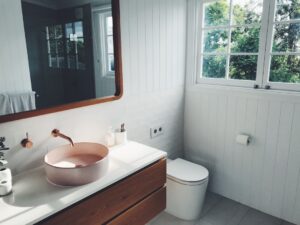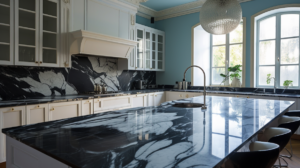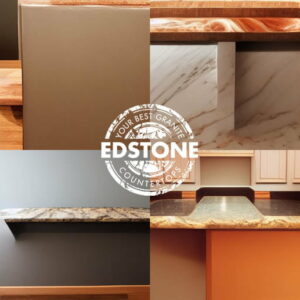When it comes to designing the perfect kitchen or bathroom, every little detail plays a critical role in shaping the overall aesthetic and functionality. While countertop materials and color palettes often take center stage, the importance of choosing the right countertop edge profiles cannot be overstated. The edge profile you select not only impacts the visual appeal of your modern kitchen countertops, but also influences how practical and user-friendly the space will be.
From traditional silhouettes to contemporary statement pieces, the edge profile sets the tone and accentuates the design of your countertops. The perfect edge can showcase the beauty of your chosen material, keep your countertops safer by smoothing out sharp edges, and even make routine maintenance more manageable. Whether you are designing a bathroom countertop or focusing on updating your busy kitchen, you’ll find that selecting the best edge for countertops is a valuable way to ensure both style and functionality.
In this comprehensive guide, we’ll explore popular and innovative edge profiles, examine how to choose the right one for your needs, and highlight emerging trends that can elevate your interior design. By the end, you’ll be well-equipped to pick an edge profile that merges with your personal style while enhancing the usability of your home. Let’s dive into the world of stylish countertop edges and discover how a simple design choice can have a lasting impact on your living spaces.

Popular Edge Profiles for Modern Kitchen Countertops
When choosing an edge profile, you’ll want to balance both design preferences and everyday practicality. Here are some of the most popular countertop edge profiles that homeowners and interior designers alike rely on to create exceptional looks.
1. Square Edge
Aesthetic Appeal:
- Minimalist and modern appearance
- Straight, clean lines perfect for contemporary kitchens
Functional Benefits:
- Simple to clean with no grooves or curves
- Edges can be slightly softened (eased edge) for comfort and safety
Best For:
- Sleek, modern kitchen countertops
- Any space where clean lines and simplicity are priorities
A square edge profile is often the go-to choice for people who favor sleek modernity or prefer a subtle, understated look. It’s not entirely “sharp”; rather, it’s commonly finished with a small radius or chamfer that rounds out the corner to prevent accidental bumps.
2. Bullnose Edge
Aesthetic Appeal:
- Soft, rounded curve that projects warmth and elegance
- Versatile look that complements a wide array of interior styles
Functional Benefits:
- Easy to clean, with no grooves where spills can collect
- Smooth edge reduces the risk of chipping and accidental injuries
Best For:
- Busy families who desire a safe and low-maintenance design
- Traditional or transitional kitchens where gentle curves are appealing
A bullnose edge is characterized by its smooth, rounded profile that softens the overall look of your countertop. This curvature helps limit breakage and potential damage to the countertop edges over time. Additionally, it’s a safe option for households with small children.
3. Half-Bullnose Edge
Aesthetic Appeal:
- Sleek halfway blend of a flat top surface and curved underside
- Contemporary twist on a classic bullnose
Functional Benefits:
- Maintains a degree of softness while keeping a crisper top edge
- Minimizes drips from running onto cabinets or floors
Best For:
- Anyone wanting a balance between a square edge and a traditional bullnose
- Modern or transitional designs that prefer a subtler curve
Not quite square but not entirely rounded, the half-bullnose edge is a hybrid that appeals to many. The top edge of the counter remains fairly straight and modern, while the bottom softly curves, bringing in a hint of traditionalism and preventing liquids from dripping directly beneath the counter.
4. Beveled Edge
Aesthetic Appeal:
- Striking, angled cut creating distinct lines
- Adds visual interest to a contemporary or traditional countertop
Functional Benefits:
- Easier to clean compared to heavily ornate profiles
- Slanted edges help reduce the likelihood of chipping
Best For:
- Spaces seeking a refined, geometric look
- Clients wanting an elegant, transitional style that merges classic and modern elements
A beveled edge is cut at a specific angle along the top edge, resulting in a crisp, distinct line that adds character without being overly complex. In addition, the angled edges can reduce visible wear on the countertop corners.
5. Ogee Edge
Aesthetic Appeal:
- Luxurious, intricate “S-shaped” curve
- Symbol of high-end traditional or classic designs
Functional Benefits:
- Makes an opulent statement, especially in formal settings
- Can be combined with other profiles for a unique, layered design
Best For:
- Traditional and ornate kitchen or bathroom countertop design
- High-end kitchens that want a timeless, grand appearance
The ogee edge is an instantly recognizable style that conveys sophistication. Its dramatic curve suits traditionally styled spaces and pairs beautifully with materials like marble or other high-end natural stones. However, this design can be slightly more challenging to clean due to the deeper curves.
6. Waterfall Edge
Aesthetic Appeal:
- Contemporary “wrap-around” look where the countertop material continues down the sides
- Creates a seamless, eye-catching focal point
Functional Benefits:
- Protects cabinetry sides from wear and tear
- Showcases the beauty of natural stone or engineered materials with a bold statement
Best For:
- Ultra-modern kitchens and bathrooms aiming for a show-stopping design
- Spaces that want to highlight the material’s pattern or veins
Unlike typical edges that finish at the corner, a waterfall edge cascades down to the floor. It’s a favorite among fans of minimalism, as it seamlessly unites countertops with cabinetry to form a cohesive, vertical statement. Though visually stunning, keep in mind that this approach often requires a bigger material investment.
7. Dupont (French) Curve
Aesthetic Appeal:
- Elegant design with a short, straight edge flowing into a cove
- Luxury appeal that is graceful yet less elaborate than an ogee
Functional Benefits:
- Smooth edge without overly intricate grooves
- Adds architectural flair without overwhelming the space
Best For:
- Transitional kitchens wanting a classic yet updated look
- Marble countertops that carry a graceful, timeless charm
The Dupont edge, sometimes referred to as the French curve, begins with a straight line at the top before curving into a concave shape. It offers a refined profile that elevates kitchen or bathroom countertops.
8. Chiseled or Natural Edge
Aesthetic Appeal:
- Raw, rustic appearance that highlights the stone’s natural texture
- Ideal for farmhouse or industrial-inspired designs
Functional Benefits:
- Retains the stone’s original form, making it a standout feature
- Conceals minor dings or chips more easily due to rough edges
Best For:
- Unique statement pieces in both kitchen and bathroom designs
- Homeowners craving a more organic, earthy aesthetic
For those seeking authenticity and a connection to nature, a chiseled edge can be the perfect fit. This rugged profile looks especially striking when paired with stone types that display bold veins and textures.

How to Choose the Right Profile for Your Countertops
Deciding on the best edge for countertops isn’t just about picking the shape that catches your eye—it involves a balance of style, material compatibility, and practical considerations. Here’s how you can simplify the decision-making process:
- Consider Your Countertop Material
- Granite & Natural Stones: Almost any edge profile can work, but more ornate designs like ogee or Dupont showcase the beauty of these stones.
- Quartz & Engineered Surfaces: Contemporary edges like square, beveled, or waterfall often suit the modern aesthetic of these surfaces.
- Laminate & Solid Surface: Not all profiles can be formed equally in these materials, so consult with your fabricator about possible edge styles.
- Match Your Interior Style
- Traditional or Classic Décor: Embrace curves (e.g., ogee, bullnose) and layered edges for a timeless appeal.
- Modern or Minimalist Homes: Opt for sleek lines (e.g., square, waterfall, beveled) that accentuate simplicity.
- Farmhouse or Rustic Aesthetics: A chiseled or natural edge can bring warmth and authenticity.
- Evaluate Practical Needs
- Safety: Rounded edges like bullnose are great for households with children.
- Maintenance: Intricate profiles collect dust and spills more readily. For easy cleaning, consider simpler shapes like square or beveled.
- Durability: Angled or bullnose edges can reduce chipping, especially in high-traffic kitchens.
- Budget Considerations
- Complex Profiles Cost More: Ogee, Dupont, and waterfall edges typically require more labor and material.
- Basic Profiles Are Affordable: Square or slight bevel edges are usually the most cost-effective choices.
By evaluating your countertop materials, home style, and practical needs, you’ll quickly narrow down your options. Speaking with a professional fabricator or interior designer can also help you weigh cost, feasibility, and aesthetics.
Modern Trends & Innovations in Countertop Edge Design
The world of stylish countertop edges continues to evolve, offering exciting possibilities for homeowners seeking something truly unique. Keep an eye on these latest developments to stay ahead of the curve.
1. Layered or Stacked Edges
One emerging trend is to layer two or more profiles to create a stacked edge. For example, pairing an ogee curve on the top with a bullnose underneath adds depth and visual intrigue. This approach creates a multilayered design that marries classic grace with contemporary flair.
2. Mitered Drop Edges
Mitered edges involve joining two pieces of material at a 45-degree angle to create a seamless, thick-looking countertop. This technique often pairs perfectly with waterfall edges to maintain a continuous visual flow. The result is a sophisticated, slab-like effect that can make a bold statement in modern kitchens and bathrooms.
3. Reverse Bevels and Hidden Grips
A reverse bevel edge, cut at an inward angle near the top, is popular for those wanting a subtle handle or grip along the underside of the countertop. Particularly useful in minimalist designs, this style allows for handle-free cabinetry, giving a streamlined appearance that exudes contemporary elegance.
4. LED-Lit Edges
For tech-savvy homeowners, integrating LED lighting into the edge of a glass or acrylic countertop is a cutting-edge option. The glow highlights the smooth lines of the surface and creates a futuristic atmosphere. While this approach leans more experimental, it can become a spectacular focal point in a modern or avant-garde setting.
5. Sculptural, Organic Shapes
As technology and fabrication methods advance, designers are experimenting with curved or sculptural edges that deviate from standard templates. Gentle waves and asymmetrical contours are increasingly available, providing a one-of-a-kind aesthetic that draws the eye and complements more artistic or nature-inspired interiors.
Conclusion: Elevate Your Countertop Style Today
Selecting the right countertop edge profiles is an integral step in shaping the look, feel, and function of your kitchen or bathroom countertop design. From timeless classics like bullnose and ogee to fresh, modern concepts like waterfall edges and mitered drops, each profile carries its own set of visual and practical benefits. By considering factors such as your material choice, budget, lifestyle requirements, and overall design theme, you’ll be better prepared to make a decision that aligns with your vision.
Whether you’re renovating an older home or designing a brand-new space, a thoughtfully chosen edge profile enhances not only the beauty of your modern kitchen countertops but also the user experience. With numerous styles to choose from, there’s undoubtedly an option that will resonate with your personal taste and elevate your home’s ambiance.
Contact us today to explore the perfect edge profile for your countertops! Let our experienced team guide you through the process, ensuring you achieve a balance of aesthetic appeal, functionality, and lasting value. By taking the time to select the best edge for countertops, you’ll invest in a design element that you’ll appreciate every day—one that flawlessly complements your unique interior style and practical needs.





